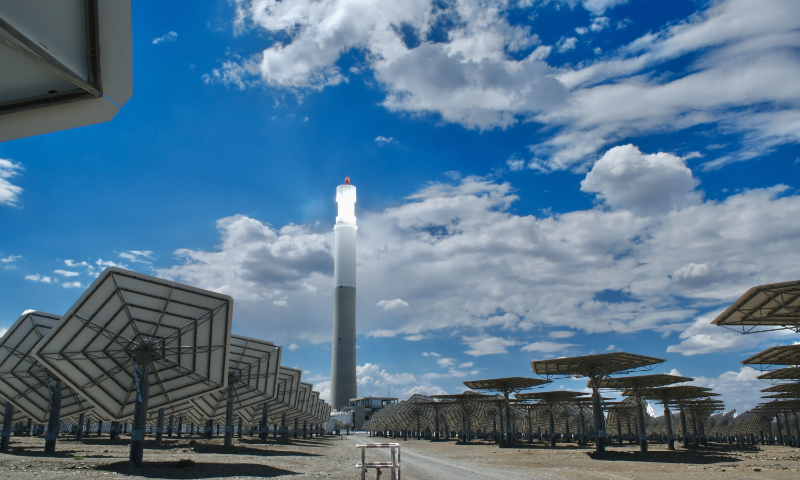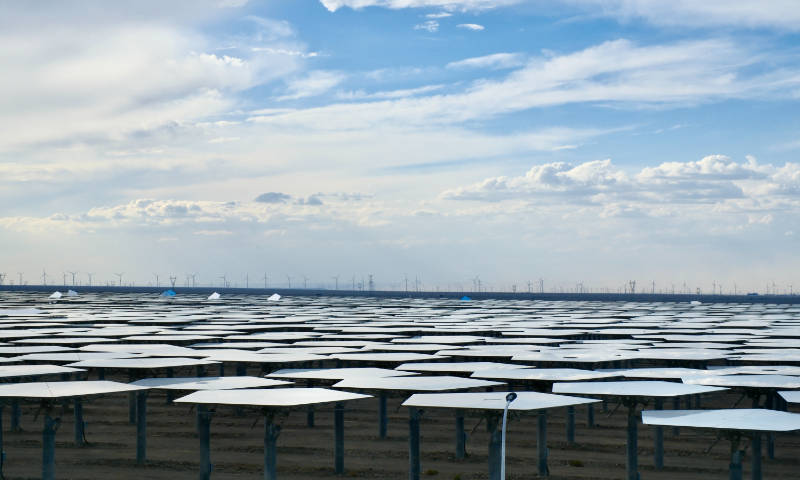
Photo taken on June 21, 2024 shows the Hami Solar Thermal Power Plant in Hami, Northwest China’s Xinjiang Uygur Autonomous Region. Photo: Zhang Yiyi/GT
In the middle of the Gobi Desert in Hami, Northwest China's Xinjiang Uygur Autonomous Region, rows of large mirrors sparkle like diamonds under the dazzling sunlight, resembling a scene from a sci-fi film. But these mirrors are not for viewing. They are installed to turn the sunlight into an endless supply of clean energy.
"There are 14,500 heliostats reflecting sunlight onto a central tower, heating molten salt to generate and store energy. After sunset, the stored energy continues to power the plant, ensuring 24-hour operation. This is the main advantage of solar thermal power," Liu Zenghui, deputy general manager at Northwest Electric Power Design Institute's New Energy Engineering Co, told the Global Times on Friday at the Hami Solar Thermal Power Plant.
Compared to photovoltaic (PV) power, solar thermal power is less well-known. PV converts sunlight directly into electricity, while solar thermal converts sunlight into heat, then into electricity. It provides continuous and stable power, making it efficient and stable - a key future trend and a critical part of China's pursuit of clean energy, industry representatives said.
And like in the fields of many new-energy technologies such as PV, China is also poised to take a leading role in solar thermal power generation after years of operation and innovation that will lead to high quality and lower costs, industry representatives noted.
Key breakthroughsDesigned by the Northwest Electric Power Design Institute, the Hami Solar Thermal Power Plant is among China's first generation of solar thermal power demonstration projects and the only solar thermal power project in Xinjiang. "Its completion marks China's construction of large-capacity solar thermal power unit from zero to one, helping the country establish and improve national standards in solar thermal design," Liu said.
There were many innovations during the construction of the Hami Solar Thermal Power Plant that helped tackle various challenges during the process, the Global Times has learned.
"The pentagonal heliostats save manufacturing materials, increase the land use efficiency, and track the sun more quickly," Qiu Tao, assistant Chief Engineer, deputy general manager of the Science and Technology Innovation Center at Northwest Electric Power Design Institute, told the Global Times on Thursday.

Photo taken on June 21, 2024 shows the Hami Solar Thermal Power Plant in Hami, Northwest China’s Xinjiang Uygur Autonomous Region. Photo: Zhang Yiyi/GT
The successful operation of the 50-megawatt Hami Solar Thermal Power Tower Plant is also due to its simulation system in Xi'an, Northwest China's Shaanxi Province, the world's first comprehensive "cloud computing" simulator for a molten salt thermal power tower plant. The system accurately simulates the actual operating environment, reducing errors and enhancing safety, said Qiu.
"It's like a rehearsal. We adjust the parameters on the simulator before applying them at the Hami plant."
Moreover, when foreign experts who were responsible for the heliostat system installation were unable to provide on-site guidance due to the COVID-19 pandemic, the Chinese team developed a commissioning plan independently that met all technical requirements, which helped advance the localization of equipment in China's solar thermal projects, with the second stage achieving a 95 percent localization rate, said Liu.
While the investment required for solar thermal power plants remain high, China is working to reduce costs and promote commercialization. According to the China Solar Thermal Alliance, the cost of electricity from tower solar thermal plants is expected to drop to 0.61 yuan per kilowatt-hour (kWh) by 2025 and to about 0.53 yuan per kWh by 2027.
"Although China's development of solar thermal energy has come relatively late, we are proficient in adopting and adapting advanced technologies. Our solar thermal projects now exceed international standards, offering high cost-effectiveness and stable quality. I believe China's solar thermal industry will ultimately lead in technology and be at the forefront of global development," Qiu said.
Clean energy
The advances in solar thermal energy, along with world-leading new energy technologies such as PV and wind turbines, is critical for China's pursuit of clean energy, industry representatives said.
China's development in the new energy sector increasingly relies on a multi-energy complementary approach to achieve energy balance. In the future, solar thermal projects may play a greater role as energy storage components to stabilize the grid. With the advancement of carbon peaking and carbon neutrality goals, solar thermal power storage projects will be even more crucial to support base load power, said Liu.

Photo taken on June 21, 2024 shows the Hami Solar Thermal Power Plant in Hami, Northwest China’s Xinjiang Uygur Autonomous Region. Photo: Zhang Yiyi/GT
In 2024, China's energy transition has accelerated even further. According to the National Energy Administration, as of the end of April, the total installed power generation capacity nationwide exceeded 3 billion kilowatts (kW), up 14.1 percent year-on-year. Solar power capacity alone reached about 670 million kW, a 52.4 percent increase year-on-year.
"From 2013 to 2023, coal consumption fell from 67.4 percent to 55.3 percent, a decrease of 12.1 percentage points. Meanwhile, non-fossil energy consumption, including wind and solar power, rose from 10.2 percent to 17.9 percent, an increase of 7.7 percentage points," said Zhang Jianhua, director of the National Energy Administration, at a press conference on Thursday.
"China's commitment to green development has optimized the energy consumption structure and advanced green, low-carbon energy," Zhang said.
The transition toward clean energy is fully reflected in a rapidly rising number of power plants across China like the Hami Solar Thermal Power Plant.
With Hami Solar Thermal Power Plant as a landmark project for the city, Hami has connected 16.208 million kW of installed capacity of new energy to the grid, the largest capacity in Xinjiang, by the end of 2023. By the end of the 14th Five-Year Plan (2021-25), Hami aims to exceed 40 million kW, making it the city with the largest new energy capacity in China.
Hami is a representative of Xinjiang's new-energy industry development. Currently, Xinjiang has over 70 million kW worth of new energy projects under construction and is accelerating the development of 10-million-kW-level new energy bases.
Xinjiang also has 13 solar thermal projects under construction, contributing to the national total of 33 projects. By 2025, Xinjiang's installed capacity of new energy is expected to exceed 116 million kW, accounting for more than half of Xinjiang's total installed capacity, which provides strong support for continuous energy structure optimization and high-quality economic development of the region.






